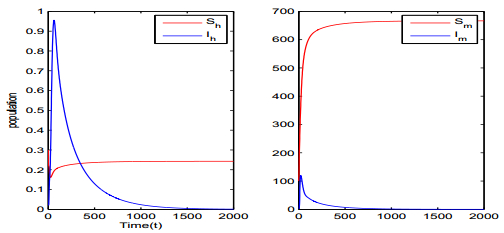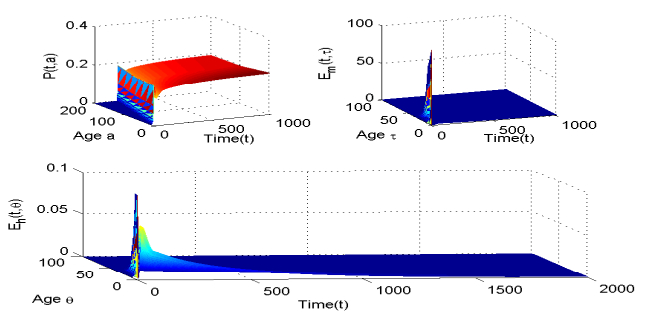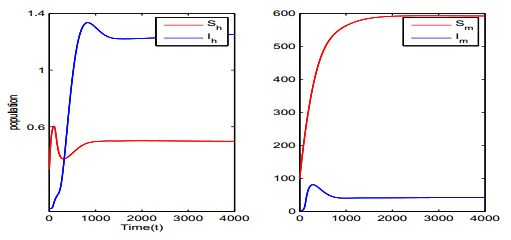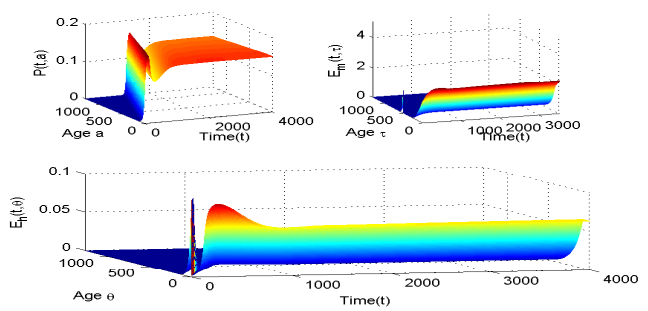In this paper, we formulate a new age-structured malaria model, which incorporates the age of prevention period of susceptible people, the age of latent period of human and the age of latent period of female Anopheles mosquitoes. We show that there exists a compact global attractor and obtain a sufficient condition for uniform persistence of the solution semiflow. We obtain the basic reproduction number R0 and show that R0 completely determines the global dynamics of the model, that is, if R0<1, the disease-free equilibrium is globally asymptotically stable, if R0>1, there exists a unique endemic equilibrium that attracts all solutions for which malaria transmission occurs. Finally, we perform some numerical simulations to illustrate our theoretical results and give a brief discussion.
1.
Introduction
Malaria, an infectious disease caused by the malaria parasite, is one of the most severe public health problems in the world. About half of the world population live in areas at risk of malaria transmission. According to the World Malaria Report 2016 [1], in 2015, there were 212 million new clinical cases of the disease and 429,000 deaths. The majority of malaria cases and deaths are concentrated in Africa. Malaria transmission between people mainly involves malaria parasites infecting successively two types of hosts: humans and female Anopheles mosquitoes. In humans, the parasites (sporozoites) grow and multiply first in the liver cells. After a period of time, the parasites are found in the red cells of the blood. The blood stage parasites are those that cause the symptoms of malaria. In the blood, the parasites grow inside the red cells and then destroy them, releasing more daughter parasites that continue the cycle by invading other red cells. A proportion of the blood stage parasites develop into the gametocytes at some point of this process. When gametocytes are ingested by a female Anopheles mosquito during a blood meal, they start another different cycle of growth and multiplication in the mosquito. After 10-18 days, the parasites (sporozoites) are found in salivary glands of the mosquito. When the anopheles mosquito takes a blood meal on another human, the sporozoites are injected with the mosquito's saliva and start another human infection when they parasitize the liver cells. Thus, the mosquito carries the disease from one human to another. Differently from the human host, the mosquito does not suffer from the presence of the parasites [2].
Mathematical modeling of malaria transmission has always provided useful insights into malaria transmission mechanism since the pioneer work of Ross [3] and Macdonald [4], it has also become an important tool in understanding the dynamics of malaria transmission. Over the years, the Ross-Macdonald model has been extended by many researchers [5,6,7,8,9,10,11,12,13]. Ruan et al. [7] introduced modified Ross-Macdonald model to include two discrete time delays which represent incubation periods of parasites within the human and the mosquito. They verified that extending the incubation periods in either humans or mosquitos were beneficial to the malaria control. Cai et al. [8] investigated the effect of distributed delays on the vector-host disease dynamics, they showed that incubation periods can play significant role in affecting the disease transmission. Gao et al. [12] presented a multi-patch malaria model to study the impact of mobility of vector and host populations on malaria transmission. By using analysis and numerical simulation, they found that human movement was a critical factor in the spatial spread of malaria around the world. Li et al. [13] investigated two malaria models with relapse. They separated the dynamics into the fast time dynamics and the slow time dynamics and showed the full dynamics were determined by the slow systems. Other models about epidemic model or age-structured can be found in [14,15,16,17,18,19,20,21,22,23,24,35].
Prevention and treatment may be the effective way to reduce malaria transmission. In most malaria-endemic countries, four interventions—case management (diagnosis and treatment), insecticide-treated nets (ITNs), intermittent preventive treatment of malaria in pregnant women (IPTp) and indoor residual spraying (IRS) —make up the essential package of malaria interventions. These measures are considered to have made a major contribution to the reduction in malaria burden since 2000. However, global investment for malaria has barely changed in recent years, which has affected malaria control to a certain extent. In 2015, 43% of the population of sub-Saharan Africa were not covered by ITNs or IRS, 69% of pregnant women did not receive three doses of IPTp and 36% of children with fever were not taken for care [1]. Prevention of malaria may be more cost-effective than treatment of the disease in the long run. In March 2010, the newest intervention recommended by the World Health Organization is intermittent preventive treatment during infancy (IPTi). Studies show that IPTi can significantly reduce clinical malaria and anemia in the first year of life, as well as hospital admissions associated with malaria infection or for any cause [1]. Intermittent preventive treatment of malaria in pregnant women (IPTp) is also a malaria intervention. WHO has recommended that pregnant women be given at least three doses during each pregnancy [1]. Vaccination is also a means of prevention. RTS, S(developed by PATH Malaria Vaccine Initiative (MVI) and GlaxoSmithKline (GSK) with support from the Bill and Melinda Gates Foundation) is the most recently developed recombinant vaccine. Phase Ⅲ clinical trial indicated that RTS, S reduced the number of cases among young children by almost 50 percent and among infants by around 25 percent. But, overall efficacy seem to wane with time [25]. According to this, we introduce age structure in the prevention period of susceptible population in our model.
Motivated by the above, in this paper, we not only introduce age structure to explain the prevention period of susceptible population but also involve age structures to account for the latent periods in humans and mosquitoes. We show that there exists a compact global attractor and obtain a sufficient condition for uniform persistence of the solution semiflow. We also identify the basic reproduction number R0 and show that R0 completely determines the global dynamics of our model.
This paper is organized as follows. In Section 2, we introduce the malaria model and present some basic properties. In Section 3, we define the basic reproductive number and prove the local stability of the disease-free equilibrium and the unique endemic equilibrium. In Section 4, we present the uniform persistence and prove the global stability of the disease-free equilibrium and the unique endemic equilibrium. In Section 5, we perform some numerical simulations. In Section 6, we give a brief discussion.
2.
Malaria model and basic properties
2.1. The model
We divide the total human population at time t into five mutually-exclusive subetaoups: susceptible individuals Sh(t), protected individuals P(t,a), where the parameter a denotes the preventive age of the susceptible individuals, exposed individuals Eh(t,θ), where θ denotes the latent age of the exposed individuals, infective individuals Ih(t) and removed individuals Rh(t). We assume that the removed individuals are given special protection, they will no longer be involved in the transmission process. We divide the total vector population at time t into three mutually-exclusive subetaoups: susceptible vectors Sm(t), exposed vectors Em(t,τ), where the parameter τ denotes the latent age of the exposed vectors, infective vectors Im(t). The flow among those subetaoups is shown in the following flowchart (Figure 1).
By the flowchart (Figure 1) and noting that the removed individuals are decoupled, we can formulate the malaria model as follows:
with the following initial and boundary conditions
where P0(a),Eh0(θ),Em0(τ)∈L1+(0,+∞) and sh0,ih0,rh0,sm0,im0∈R+. The meanings of the parameters in (2.1) are explained in Table 1.
Throughout this paper, we make the following assumptions and notations.
(A1): Λi,μi,βi,δ,α>0,(i=1,2), ψ≥0;
(A2): γi∈L∞+(0,+∞) (i=1,2,3) with essential upper bounds ¯γi>0, respectively;
(A3): P(0,0)=ψSh(0), Eh(0,0)=bβ1Sh(0)Im(0), Em(0,0)=bβ2Sm(0)Ih(0).
For a,θ,τ≥0, we denote
k1(a)=e−∫a0(μ1+γ1(s))da, K1=∫+∞0γ1(a)k1(a)da, ϕ(a)=ψγ1(a)k1(a),
k2(θ)=e−∫θ0(μ1+γ2(s))dθ, K2=∫+∞0γ2(θ)k2(θ)dθ,
k3(τ)=e−∫τ0(μ2+γ3(s))dτ, K3=∫+∞0γ3(τ)k3(τ)dτ,
Y=R4+×(Ł1+(0,+∞))3 with norm
2.2. Well-posedness
Base on the above assumptions, we can verify the local existence of unique and nonnegative solution of the model (2.1) with the nonnegative initial conditions (see Webb [26] and Iannelli [27]), thus obtain the following proposition.
Proposition 2.1. Let x0∈Y, then there exists ϵ>0 and neighborhood B0⊂Y with x0∈B0 such that there exists a unique continuous function, Φ:[0,ϵ]×B0→Y, where Φ(t,x0) is the solution to (2.1) with Φ(0,x0)=x0.
For t∈[0,ϵ],
and setting μ=min{μ1,μ2}, we deduce that ∥Φ(t,x0)∥Y satisfies the following inequality:
therefore
which yields
Boundedness is a direct consequence of nonnegativity of solutions. Then we have following proposition.
Proposition 2.2. Let x0∈Y, then there exists a unique continuous semiflow, Φ:R+×Y→Y, where Φ(t,x0) is the solution to (2.1) with Φ(0,x0)=x0, and (2.3),(2.4) are satisfied for t∈R+. The following set is positively invariant for system (2.1)
From Proposition2.2. and (2.3), we obtain the following proposition.
Proposition 2.3. (1) The solution of (2.1), Φ(t,⋅), is point dissipative and Ω attracts all points in Y;
(2) Let B⊂Y be bounded, then Φ(t,B) is bounded;
(3) If x0∈Y and ∥x0∥Y≤A for some A≥Λ1+Λ2μ, then Si(t), Ii(t),∥P(t,⋅)∥L1+,∥Ei(t,⋅)∥L1+≤A,(i=h,m).
2.3. Asymptotic smoothness
Integrating the equations for P,Eh,Em in (2.1) along the characteristic lines, t−a = const., t−θ = cost., t−τ = const., respectively, we have
Continuous semiflow {Φ(t,⋅)}t≥0 is said to be asymptotically smooth, if each positively invariant bounded closed set is attracted by a nonempty compact set.
We will use the following two lemmas [28] to prove the asymptotic smoothness of the semiflow.
Lemma 2.1. The semiflow Φ:R+×Y→Y is asymptotically smooth if there are maps U1,U2:R+×Y→Y such that Φ(t,x)=U1(t,x)+U2(t,x), and the following hold for any bounded closed set A⊂Y that is forward invariant under Φ:
(1) limt→+∞diamU2(t,A)=0;
(2) there exists tA≥0 such that U1(t,A) has compact closure for each t≥tA.
Since Y is an infinite dimensional space, infinite dimensional space L1+(0,+∞) is a component of Y. For infinite dimensional space, we cannot deduce precompactness only from boundedness. We apply following lemma.
Lemma 2.2. Let B be a bounded subset of L1+(0,+∞). Then B has compact closure if and only if the following conditions hold:
(i) supf∈B∫+∞0∣f(s)∣ds<+∞;
(ii) limh→+∞∫+∞h∣f(s)∣ds=0 uniformly in f∈B;
(iii) limh→0+∫+∞0∣f(s+h)−f(s)∣ds=0 uniformly in f∈B;
(iv) limh→0+∫h0∣f(s)∣ds=0 uniformly in f∈B.
We are now ready to prove a result on the semiflow Φ generated by system (2.1) is asymptotically smooth.
Theorem 2.3. The semiflow Φ generated by system (2.1) is asymptotically smooth.
The proof of this theorem is in the appendix section.
Combining Proposition 2.3 and Φ is asymptotically smooth, as well as the existence theory of global attractors, the following result is immediate from Theorem 2.6 in [29] and Theorem 2.4 in [30].
Theorem 2.4. The semiflow Φ has a global attractor A in Y, which attracts any bounded subset of Y.
3.
Equilibria and their local stability
3.1. Existence of equilibria
System (2.1) always has the disease free equilibrium E0=(S0h,S0m,0,0,P0(a),0L1,0L1), where
Define the basic reproduction number by
R0 represents the average number of secondary infectious human cases produced by a primary infectious human case that is introduced into two entirely susceptible populations: humans and female anopheles mosquitoes. The biological relevance of the threshold R0 can be interpreted as follows. There are
susceptible people and Λ2μ2 susceptible female anopheles mosquitoes. A primary infectious human case has a removal rate μ1+α+δ, the average infectious period is
During this time, the average number of mosquito bites from the susceptible mosquitoes is
so that the average number of infected but not infectious mosquitoes from the infectious human case will be
Then
represents the total number of infectious female anopheles mosquitoes produced by infected but not infectious mosquitoes. The infectious mosquitoes have a removal rate μ2, the average infectious period is 1μ2. During this time, the average number of mosquito bites from the susceptible mosquitoes is bμ2, so that the average number of infected but not infectious human cases from the infectious mosquitoes will be
Then
represents the average number of infectious human cases produced by infected but not infectious human cases. Therefore, the average number of secondary infectious human cases from a primary infectious human case is
which is R0.
Next, we investigate the endemic equilibria of system (2.1). Any endemic equilibrium (S∗h,S∗m,I∗h,I∗m,P∗(a),E∗h(θ),E∗m(τ)) of system (2.1) should satisfy the following equations:
From (3.1) we can easily find that if R0>1, system (2.1) has a unique endemic equilibrium E∗=(S∗h,S∗m,I∗h,I∗m,P∗(a),E∗h(θ),E∗m(τ)), where
Summarizing the discussions above, we have the following theorem.
Theorem 3.1. System (2.1) always has the disease free equilibrium E0. Moreover, apart from E0, if R0>1, system (2.1) has a unique endemic equilibrium E∗.
3.2. Local stability of the equilibria
Now we consider the linearized system of (2.1) at an equilibrium
Let ¯Sh(t)=Sh(t)−~Sh, ¯Sm(t)=Sm(t)−~Sm, ¯Ih(t)=Ih(t)−~Ih, ¯Im(t)=Im(t)−~Im, ¯P(a,t)=P(a,t)−˜P(a), ¯Eh(t,θ)=Em(t,θ)−~Eh(θ), ¯Em(t,τ))=Em(t,τ)−~Em(τ), then removing the bar, we obtain the following linearized system:
with the following initial and boundary conditions
Let
For (3.2), let Sh(t)=S0heλt, Sm(t)=S0meλt, Ih(t)=I0heλt, Im(t)=I0meλt, P(t,a)=P0(a)eλt,Eh(t,θ)=E0h(θ)eλt,Em(t,τ)=E0m(τ)eλt, we have
with initial conditions
We obtain from the system (3.3) that
On substituting the above two equations into the second and third equations of system (3.4), and by simple calculation, we have
and
We derive that
We obtain the characteristic equation of model (2.1) at an equilibrium ˜E as follows:
where f(λ)=b2β1β2K2(λ)K3(λ)~Sh~Sm(λ+μ1+ψ(1−K1(λ))(λ+μ1+α+δ)(λ+μ2+bβ2~Ih)(λ+μ1+ψ(1−K1(λ))+bβ1~Im).
Theorem 3.2. (Local stability)
(i) The disease-free equilibrium E0 of system (2.1) is locally stable if R0<1 and unstable if R0>1.
(ii) The endemic equilibrium E∗ of system (2.1) is locally stable if R0>1.
Proof. First consider the local stability of the disease-free steady state E0.
Clearly, we have f(0)=R0, f′(λ)<0 and limλ→∞f(λ)=0. Hence, if R0>1, then f(λ)=1 has a unique positive real root. Thus, if R0>1, the disease-free steady state E0 is unstable.
If R0<1, the disease-free equilibrium E0 is locally stable. Otherwise, f(λ0)=1 has at least one root λ0=a1+ib1 satisfying a1≥0. But
Hence, if R0<1, all roots of f(λ)=1 have negative real parts, then the disease-free equilibrium E0 is locally stable.
Next, we consider the local stability of the endemic equilibrium E∗.
If R0>1, the endemic equilibrium E∗ is locally stable. Otherwise, f(λ∗)=1 has at least one root λ∗=a2+ib2 satisfying a2≥0. But
Notice, S∗hS∗m=(μ1+α+δ)μ2b2β1β2K2K3, we know ∣f(λ∗)∣<1, Hence, if R0>1, all roots of f(λ)=1 have negative real parts, then the endemic equilibrium E∗ is locally stable. This completes the proof.
4.
Uniform persistence and global stability
4.1. Uniform persistence
In this subsection, our purpose is to show that system (2.1) is uniformly persistent when R0>1. Define
let ∂M0=Y∖M0, then we have Y=M0∪∂M0.
Theorem 4.1. The sets M0 and ∂M0 are forward invariant under the semiflow Φ(t,⋅). Also, the disease-free equilibrium E0 of system (2.1) is globally asymptotically stable for the semiflow Φ(t,⋅) restricted to ∂M0.
The proof of this theorem is in the appendix section. Theorem 4.1 states that if the number of people and mosquitoes initially infected by plasmodium belongs to ∂M0, then malaria will eventually die out. But if the number of people and mosquitoes initially infected by plasmodium belongs to M0, then whether malaria is eventually extinct, we need to verify by the following Theorem 4.2, Theorem 4.3 and Theorem 4.5.
Theorem 4.2. If R0>1, then semiflow {Φ(t,⋅)}t≥0 generated by system (2.1) is uniformly persistent with respect to the decomposition (M0, ∂M0). Moreover, there is a compact subset A0⊂M0, which is a global attractor for {Φ(t,⋅)}t≥0 in M0.
Details of this proof are in appendix section. Theorem 4.2 shows that if R0 is greater than 1, when the number of people and mosquitoes initially infected by plasmodium belongs to M0, malaria will always exist at a certain scale.
4.2. Global stablility
Let x∈A, we can find a complete orbit {Φ(t,⋅)}t∈R through x in A. By similar analytical method used in [[31], subsection 3.2], system (2.1) can be written as
Theorem 4.3. The disease-free equilibrium E0 of system (2.1) is globally asymptotically stable if R0<1.
The proof of this theorem is in the appendix section. Theorem 4.3 shows that if R0 is less than 1, malaria will be extinct regardless of whether the number of people and mosquitoes initially infected by plasmodium belongs to M0 or ∂M0.
If R0>1, we have know that the system (2.1) is uniformly persistent and has a global attractor A0 in M0, meanwhile, let (Sh(0), Sm(0), Ih(0), Im(0), P(0,a), Eh(0,θ), Em(0,τ))∈A0, system (2.1) can be written as (4.1) (replace A with A0). In order to study the global stability of E∗, we first prove the following lemma.
Lemma 4.4. There exist ϵ,M>0 such that all solutions in A0 for t∈R, the following inequalities are satisfied
Proof. Let (Sh(t),Sm(t),Ih(t),Im(t),P(t,a),Eh(t,θ),Em(t,τ))∈A0.
First we prove that Sh(t)>0, Sm(t)>0 for t∈R. We assume that there exists t1∈R such that Sm(t1)=0. From (4.1) we have dSm(t1)dt≥Λ1>0, then ∃ η>0 such that Sm(t1−η)<0. This contradicts the A0⊂M0. Thus, Sm(t)>0 for t∈R. Similarly, we can get Sh(t)>0 for t∈R.
Next we prove that Ih(t)>0, Im(t)>0 for t∈R. First we assume that there exists t0∈R such that Ih(t0)=0 and Im(t0)=0, then according to Ih(t), Im(t) equations in (4.1), we can deduce that Ih(t)=0, Im(t)=0 for t≤t0. Next form (4.1) we know ∫+∞0Eh(t,θ)dθ=∫+∞0k2(θ)bβ1Sh(t−θ)Im(t−θ))dθ=0, ∫+∞0Em(t,τ)dτ=∫+∞0k3(τ)bβ2Sm(t−τ)Ih(t−τ))dτ=0 for all t≤t0, then obviously, ∫+∞0γ2(θ+s1)Eh(t,θ)dθ=0, ∫+∞0γ3(τ+s2)Em(t,τ)dτ=0 for all s1, s2≥0. This contradicts the A0⊂M0. On the other hand, we assume that there exists t0∈R such that one of Ih(t0), Im(t0) is positive, so without loss of generality, we assume that Ih(t0)=0, Im(t0)>0. Similarly, we have Ih(t)=0, ∫+∞0γ3(τ+s)Em(t,τ)dτ=0 for all s≥0,t≤t0. Then dIm(t)dt=−μ2Im(t) for all t≤t0, we deduce that Im(t0)=Im(t)e−μ(t0−t), obviously, Im(t)→+∞ as t→−∞. This contradicts the compactness of A0. Hence, Ih(t)>0, Im(t)>0 for all t∈R. In addition, from (4.1), we deduce that P(t,a)>0,Eh(t,θ)>0, Em(t,τ)>0 for t∈R,a,θ,τ∈R+.
According to the compactness of A0, we know there exist ϵ,M>0 such that
The proof is complete.
Theorem 4.5. If R0>1, then endemic equilibrium E∗ of system (2.1) is globally asymptotically stable in M0.
Details of this proof are in appendix section. Theorem 4.5 shows that if R0 is greater than 1, when the number of people and mosquitoes initially infected by plasmodium belongs to M0, the number of people and mosquitoes will eventually stabilize at E∗.
5.
Simulations for the malaria model
In this section, we present some numerical simulations to confirm the above theoretical results (i.e., Theorems 4.3 and 4.5). Some of the parameters are taken from[8] b=0.2,β1=0.015,δ=0.05,μ1=0.00004. Other parameters are estimated. we estimate other parameters as follows Λ1=0.2,Λ2=20,β2=0.015,μ2=0.03,α=0.001. Moreover, we assume that the prevention wane rate and the removal rate from latent class take the form
where i=1,2,3, t1=12,t2=7,t3=10 (time units are days), γ1=0.001,γ2=0.11,γ3=0.1. By solving R0=1, we obtain that ψ0=0.4872. Obviously, R0 decreases as the degree of prevention ψ increases. Thus, first, we let ψ=0.9>ψ0, we can compute R0=0.5414<1, then the disease-free equilibrium E0=(0.2426,666.667,0,0,0.2183k1(a),0,0) is globally stable, as depicted in Fig. 2, Fig. 3. Next, we let ψ=0.3<ψ0, we can compute R0=1.6239>1, then the endemic equilibrium E∗=(0.5025,594.5913,1.2122,41.0726,0.1507k1(a),0.0619k2(θ),2.1623k3(τ)) is globally stable, as depicted in Fig. 4, Fig. 5. From the numerical simulations we can conjecture that increasing ψ, the rate of prevention of the susceptible people, can eliminate malaria. This is consistent with the report [1] of the WHO that prevention is considered to have made a major contribution to the reduction in malaria burden since 2000.
6.
Discussion and conclusion
Malaria is a dangerous and sometimes fatal disease caused by malaria parasite that commonly infect female anopheles mosquitoes which take a blood meal on humans. It is one of the greatest challenges in the field of global public health. The cost of malaria to individuals, families, communities, nations is huge. This issue may become more serious due to lack of prevention. In our paper, we considered an age-structured malaria epidemic model with prevention period of susceptible people and latent period of two types of infected hosts. The basic reproduction number R0 of our model (2.1) has been found by the definition. Based on regional division of state space and selection of appropriate Lyapunov functions, we proved that disease-free equilibrium E0 is globally asymptotically stable if R0<1, while endemic equilibrium E∗ is globally asymptotically stable in M0 if R0>1.
We are easy to see that R0 decreases as the rate of prevention ψ increases, that is, increasing the degree of prevention can lead to malaria extinct. Thus, the prevention is very important for the control of malaria. If we don't take into account the prevention period and latent period of two types of infected hosts, and according to the dynamics of the ODE model in [32], we can easily know that the basic reproduction number R0 is reduced to ¯R0=b2β1β2Λ1Λ2(μ1+α+δ)μ1μ22, in addition, notice that K1<1, K2<1, K3<1, we can find that R0<¯R0, so considering the prevention period and latent period of two types of infected hosts can reduce the basic reproduction number, which are beneficial to understanding the dynamics of malaria control.
Acknowledgments
This work is supported by the NNSF of China(11861044and11661050), the NSF of Gansu Province (148RJZA024), and the HongLiu first-class disciplines Development Program of Lanzhou University of Technology. We are grateful to the anonymous referees and the editors for their valuable comments and suggestions which improved the quality of the paper.
Conflict of interest
All authors declare no conflicts of interest in this paper.
Appendix
Proof of Theorem 2.3
Proof. We first decompose Φ into the following two parts: U1,U2 defined respectively by
where
for x=(Sh(0),Sm(0),Ih(0),Im(0),P0(a),Eh0(θ),Em0(τ)), clearly, we have Φ(t,x)=U1(t,x)+U2(t,x).
Let A⊂Y, r is a constant greater than Λ1+Λ2μ, for each x∈A, we have ∥x∥Y≤r.
Thus, limt→+∞diam U2(t,A)=0. In the following we show that U1(t,A) has compact closure for each t≥0.
From Proposition 2.3, we know that Si(t),Ii(t) (i=h,m) remain in the compact set [0,r] for all t≥0. Next, we will show that ˜P(t,a),~Eh(t,θ) and ~Em(t,τ) remain in a precompact subset of L+1(0,+∞) which is independent of x.
It is easy to show that
Therefore, the conditions (i), (ii) and (iv) of Lemma 2.2 are satisfied. Now, we only to check the condition (iii) of Lemma 2.2.
Notice that ∣dIh(t)dt∣≤ˉγ2r+(μ1+α+δ)r, ∣dSm(t)dt∣≤Λ1+(μ1+φ)r+bβ1r2+¯γ1r, we have
Then
Hence,
Thus, condition (iii) of Lemma 2.2 holds, then we can get that ~Em(t,τ) satisfies the conditions of Lemma 2.2. In a similar way, ˜P(t,a), ~Eh(t,θ) also satisfy the conditions of Lemma 2.2. Therefore, we obtain U1(t,A) has compact closure for each t≥0, Using Lemma 2.1, we know semiflow Φ is asymptotically smooth. This completes the proof.
Proof of Theorem 4.1
Proof. First we prove M0 is forward invariant under the semiflow Φ(t,⋅). Let Φ(0,x0)∈M0, if Ih(0)>0 or Im(0)>0, From (2.1), it's easy to know Ih(t)≥Ih(0)e−(μ1+α+δ)t>0 or Im(t)≥Im(0)e−μ2t>0, then M0 is forward invariant. Otherwise, if Ih(0)=Im(0)=0, then without loss of generality, ∃ t1∈R+ such that ∫+∞0γ2(θ+t1)Eh(0,θ)dθ>0 ( x0∈M0).
∀ t∈[0,t1], ∃ s=t1−t≥0 such that
If ∃ t2∈(0,t1] such that Ih(t2)>0, then Ih(t)>0, ∀t>t2, otherwise, since
we know Ih(t)>0 for all t>t1. Hence, Φ(t,M0)⊂M0.
This completes the fact that Φ(t,M0)⊂M0, i.e. M0 is forward invariant under the semiflow Φ(t,⋅).
Next, we will prove ∂M0 is forward invariant under the semiflow Φ(t,⋅). Let Φ(0,x0)∈∂M0, we consider the following system
Since Sh(t), Sm(t)≤Δ, where Δ=max{Λ1+Λ2μ,∥x0∥Y}, it follows that
where
with the following initial and boundary conditions
By use of Volterra formulation, we have
Substituting (6.5) into the first two equations of (6.3) yield
where
Since
due to Φ(0,x0)∈∂M0, then F1(t)≡0 for t≥0. In a similar way, we have F2(t)≡0 for t≥0. Accordingly, (6.6) has a unique solution ˆIi(t)≡0,(i=h,m) for t≥0.
From (6.5), we know that ˆEi(t,s)=0,(i=h,m) for 0≤s≤t. Thus, for all u≥0,
Similarly, we have ∥γ3(τ+u)ˆEm(t,τ)∥L1+=0.
By using (6.2) we can obtain that Ih(t)=0, Im(t)=0,∥γ2(θ+u1)Eh(t,θ)∥L1+=0,∥γ3(τ+u2)Em(t,τ)∥L1+=0 for t,u1,u2≥0, and Eh(t,θ), Em(t,τ)→0 as t→+∞. Thus, ∂M0 is forward invariant under the semiflow Φ(t,⋅).
Finally, we prove the disease-free equilibrium E0 of system (2.1) is globally asymptotically stable for the semiflow Φ(t,⋅) restricted to ∂M0. In ∂M0, system (2.1) can be divided into the following two subsystems
Obviously, limt→+∞Sm(t)=Λ2μ2. (6.7) has unique equilibrium (S0h, P0(a))=(Λ1μ1+ψ(1−K1),ψS0hk1(a)), and Sh(t)>0, ∫+∞0P(t,a)da>0 for t>0. Similar to the analysis of the section 2, (6.7) has a global attractor A1 of bounded sets in (0,+∞)×(L1+(0,+∞)∖0L1).
Let x∈A1, we can find a complete orbit {Φ(t,⋅)}t∈R through x in A1. By similar analytical method used in [[31], subsection 3.2], system (6.7) can be written as
Meanwhile, we easily find that (6.9) can be written as
Using similar to the proof of lemma 4.2[33], we can get that any solution in A1 is satisfied that Sh(t)>0 for t∈R. Once the stability of system (6.10) is obtained, in combination with (6.9), we can obtain the stability of system (6.7). In the following, we will define Lyapunov functionals on A1. Define
It is not difficult to find that V0(t) is positive-definite with S0h as its global minimum point. Since compactness of A1, we can easily deduce V0(t) is bounded on A1. Calculating the derivative of V0(t) along the solution of system (6.10), we obtain have
In addition, we have noted that Λ1=(μ1+ψ)S0h−∫+∞0ϕ(a)S0hda, it follows that
Notice that K1<1, then dV0dt≤0 holds. Furthermore, the strict equality holds only if Sh(t)=S0h. Consequently, S0h of (6.10) is globally asymptotically stable. In combination with (6.9), we have (S0h, P0(a)) of (6.7) is globally asymptotically stable. Hence, the equilibrium E0 is globally asymptotically stable restricted to ∂M0. The proof of Theorem 4.1 is complete.
Proof of Theorem 4.2
Proof. Since the disease-free equilibrium E0 is globally asymptotically stable restricted to ∂M0, applying Theorem 4.2 in [34], we need only to prove
where Ws(E0)={x∈Y :limt→+∞Φ(t,x)=E0}. By way of contradiction, we assume that there exists a x0∈M0 such that x0∈Ws(E0). Then we can find a list of {xn}⊂M0 such that
Denote Φ(t,xn)=(Shn(t),Smn(t),Ihn(t),Imn(t),Pn(t,⋅),Ehn(t,⋅),Emn(t,⋅)). Then for all t≥0, we have
and Φ(t,xn)⊂M0. Similar to the first part of theorem 4.1 proof, we know that there exists t0≥0 such that Ihn(t)>0 for t≥t0 or Imn(t)>0 for t≥t0, so without loss of generality, we can take t0=0 and Ihn(0)>0. Since R0>1, we can choose large enough n such that S0h>1n, S0m>1n and
Now we construct the following system
Using similar analysis of Sect.2, we can get existence, uniqueness, and nonnegative of solution to system (6.11). By the comparison principle, we know
By use of Volterra formulation, we have
Substituting (6.13) into the first two equations of (6.11) yield
We can claim that at least one of ˆIh(t),ˆIm(t) is unbounded. Otherwise, we can use Laplace transform in the first two inequations of (6.14) yield
where L[ˆIi](λ)=∫+∞0e−λtˆIi(t)dt, (i=h,m) for (λ>0), L[u1](λ)=∫∞0bβ1(S0h−1n)γ2(θ)k2(θ)e−λθdθ and L[u2](λ)=∫∞0bβ2(S0m−1n)γ3(τ)k3(τ)e−λτdτ for (λ≥0).
After a simple calculation, we obtain
L[u1](λ)→L[u1](0),L[u2](λ)→L[u2](0) as λ→0 by the Dominated Convergence Theorem.
Since
then there exists ε>0 such that
for all λ∈[0,ε). According to (6.16), we have L[ˆIh](λ)<0 for all λ∈(0,ε). But this contradicts the nonnegative of ˆIh(t), (t≥0). Hence, at least one of ˆIh(t),ˆIm(t) is unbounded. Since Iin(t)≥ˆIi(t),(i=h,m), we get that at least one of Ihn(t),Imn(t) is unbounded. This contradicts the proposition 2.3. Therefore, Ws(E0)∩M0=∅. By Theorem 4.2 [34], we get that semiflow {Φ(t,⋅)}t≥0 generated by system (2.1) is uniformly persistent. By Theorem 3.7 [29], we get that there exists a compact subset A0⊂M0 which is a global attractor for {Φ(t,⋅)}t≥0 in M0.
Proof of Theorem 4.3
Proof. Using similar to the proof of lemma 4.2[33], we can get that any solution in A is satisfied that Sh(t), Sm(t)>0 for t∈R.
Let g(x)=x−lnx−1, note that g(x) is non-negative and continuous on (0,+∞) with a unique root at x=1. Next, we construct the following Lyapunov function L=L1+L2+L3 on the global attractor A, since compactness of A, we can easily deduce L is bounded on A, where
Calculating the derivative of L1, L2, L3 along solutions of system (4.1), respectively. In the process of calculate the time derivative of L1, we used Λ2=μ2S0m, Λ1=(μ1+ψ)S0h−ψK1S0h, ∫+∞0ϕ(a)∫a0g(Sh(t−r)S0h)drda=∫+∞0ϕ(a)∫tt−ag(Sh(r)S0h)drda and ∫+∞0ϕ(a)da=ψK1. We can deduce
Therefore,
Notice that K1<1, if R0<1, then dLdt≤0 holds. Let T is the largest invariant subset of {dLdt∣(4.1)=0}, the equality holds only if Sm(t)=S0m, Sh(t)=S0h, Ih(t)=0. In T, Sm(t)=S0m for all t, then we have dSh(t)dt≡0. Combining this with (4.1), it follows that Im(t)=0 for all t, moreover, P(t,a)=ψS0hk1(a), Em(t,τ)=0, Eh(t,θ)=0 for all t∈R, a, θ, τ∈R+. Hence, T={E0}. Assume that there exists x∈A∖T and we can find Φ(t,x)⊂A through x at t=0, with alpha limit set α(x). Since x≠E0, we can deduce that t→L(Φ(t,x)) is a non-increasing and bounded function, then L is a constant on α(x). Since α(x) is invariant in A, we know α(x)=T. From Theorem 3.2 we know that the disease free equilibrium E0 is locally asymptotically stable, which implies x=E0, this contradicts the x≠E0. Hence, A={E0}. This proves that E0 is globally asymptotically stable. This completes the proof.
Proof of Theorem 4.5
Proof. We define the following Lyapunov function V=V1+V2+V3+V4+V5+V6 on the global attractor A0, using lemma 4.4, we can easily deduce V is bounded on A0, where
Calculating the derivative of V along a solution in A0. In the process of calculate the time derivative of V1, we notice that Λ1=bβ1S∗hI∗m+(μ1+ψ)S∗h−∫+∞0ϕ(a)S∗hda.
By using
we have
Recalling that I∗h=K2E∗h(0)μ1+α+δ, then
Thus,
Notice that Λ2=bβ2S∗mI∗h+μ2S∗m, we can get
Notice that ∂∂τg(Em(t,τ)E∗m(τ))=1E∗m(τ)(1−E∗m(τ)Em(t,τ))(∂Em∂τ+(μ2+γ3(τ))Em), we have
Notice that I∗m=K3E∗m(0)μ2, we have
Thus,
By using ∫+∞0γ2(θ)E∗h(θ)dθK2E∗h(0)=1, ∫+∞0γ3(τ)E∗m(τ)dτK3E∗m(0)=1, we can get
It follows from the non-negativity of g, we know that dVdt≤0, and
Let T∗ is the largest invariant subset of {dVdt∣(4.1)=0}, then we have dSh(t)dt≡0, dSm(t)dt≡0. Combining this with (4.1), we can obtain that Ih(t)=I∗h for all t, P(t,a)=ψS∗hk1(a). Further, Im(t)=I∗m for all t, in combining with (6.17), we can get Eh(t,θ)=E∗h(θ), Em(t,τ)=E∗m(τ). Hence, T∗={E∗}. According to the proof of the theorem 4.3, we can easily obtain that A0={E∗}. This proves that E∗ is globally asymptotically stable. The proof is complete.
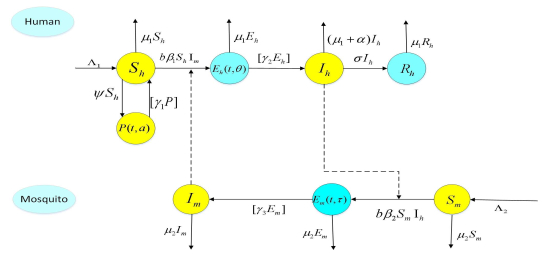









 DownLoad:
DownLoad:
